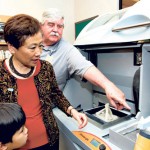Definitely Not Old School
It’s all about the kids for state schools superintendent Kathryn Matayoshi, whose philosophy is ‘Don’t make excuses and figure out a way to make it better’ – and it’s working wonders
State schools superintendent Kathryn Matayoshi is committed to doing the right thing for the students by fixing Hawaii’s troubled schools – and she refuses to hear excuses or accept failure
“If can, can. If no can, how can?”
This paraphrase of the pidgin profession of pragmatism was coined by Mary Correa, state Department of Education complex area superintendent for Kau-KeaauPahoa (Hawaii Island), as a way of embodying her complex area’s view on improving its schools. It serves as a perfect metaphor for the work that her boss, DOE Superintendent Kathryn Matayoshi, aspires for all of the state’s 254 schools: Don’t make excuses, and figure out a way to make it better.
“Just make sure you are always trying to do the right thing for the kids,” says Matayoshi, who was appointed to the position in 2010. “If you make a mistake, you fix it and try not to do that again. It is not about blame; it is about are you trying to do the right thing for kids.”
Her refusal to accept failure as an option has borne much fruit lately. Schools’ test scores have been improving, especially in troubled areas like Correa’s and the Leeward coast of Oahu. She designated 18 schools in those two areas as Zones for School Innovation, meaning students were given an extra hour of school time four days a week, and teachers were given extra professional development days to hone their craft.
In an unprecedented development from this effort, six of the nine schools in Correa’s area achieved Adequate Yearly Progress (defined by the U.S. No Child Left Behind Act).
“Leadership is key to fixing troubled schools,” says Matayoshi of Correa’s staff. “Part of being a unified team is to ask each other really hard questions and to ask for help. No trying to hide things because you are worried about what somebody might think, but it is all about the kids and getting better.”
Success also is being witnessed at the state level. A year after Matayoshi took office, the DOE was hit with a “high-risk” label for its $75 million Race to the Top (RTTT) grant, meaning if changes were not made, the funds would have to be returned.
Progress had to be made. Matayoshi appointed Steve Schatz as assistant superintendent for school reform under the RTTT program, and just this month received a letter confirming that the “high-risk” status had been removed in two of the five areas.
“He knows what he is doing,” says Matayoshi of Schatz. “He is a former complex area superintendent, principal and teacher, but also someone who is very results-oriented. He was able to focus us on the right things and to get everybody moving.”
This still leaves three areas to improve upon with the next evaluation in April, but the letter from the U.S. Department of Education sent to Gov. Neil Abercrombie roundly approved the progress.
“Hawaii is clearly making gains in its reform efforts, as evidenced in the implementation of the Common Core Standards and the progress of its students,” said Council of Chief State School Officers executive director Chris Minnich. “I applaud Superintendent Matayoshi, Department of Education staff and educators around the state for their collaboration and determination to improve education for Hawaii students.”
So how is Matayoshi making these strides in the often-derided DOE?
Perhaps the answer comes not from how she does it, but in who she is.
Never an educator – she’s a lawyer by trade – Matayoshi’s resumé contains none of the accolades of the usual administrator, but rather those you would expect to find for a CEO: chief of staff on the Board of Water Supply, executive director of Hawaii Business Roundtable and director of the state Department of Commerce and Consumer Affairs.
Being an outsider to the game, she came in not trying to change teaching styles to match hers, but rather fixing the back-office support that would allow our teachers to do what they do best.
“Every job has taught me something, and all that I have learned seems to be applicable to a certain situation at the DOE,” says Matayoshi. “People forget what a huge operation this is – $1.4 billion in general funds, more than 20,000 employees. The business side of things needs to run smoothly so that the teachers can concentrate on teaching and principals can concentrate on leading in their schools.
“My business background has been helpful at this point in time for the DOE in order to get us back running efficiently. We are not there yet, but with a lot of hard work I think we can put some systems in place, repair some systems that have gotten out of date and get it to where it is humming.”
The size of the department often has been discussed as a concern – Hawaii is the only state that has a statewide DOE, but Matayoshi believes we can use the girth of the organization to our advantage.
“We need to know when to leverage size, and when to provide the autonomy at the local and community level,” says Matayoshi, “and that has not been clear enough to me. But we are getting there now, using our size strategically and then using our complex superintendents to bring decision-making closer to the school level, where it counts the most.”
Avoiding tinkering with what is outside her realm of expertise may be her strongest suit and could be the key to getting communities reinvested in their kids’ education.
“If the students, teachers and staff are saying a certain program is what they really want, then we are going to support it,” says Matayoshi. “Those programs are hugely successful. They are driven by need in the community, they are driven by desire on the part of the staff – that is when they are going to be successful. That is not a decision we make from the state level no matter how tremendous the program is, because not all schools are ready for it, and not all schools want it or need it.”
As the head of one of the largest employers in the state, having the CEO mentality is crucial to how to constantly better her product.
“It is a healthy thing to re-evaluate something you have been doing for a long time and ask ‘is it working?’ Find what is the most impactful for schools and spend our money on that,” Matayoshi says.
That is just what the DOE did with the RTTT money, knowing that as a one-time windfall, it was important for it to have a long-term impact.
“What we were very careful about when we applied was the ‘cliff effect,’ that once the money is gone, is everything going to fall off the cliff and disappear,” says Matayoshi. “Our philosophy was to invest in assets and systems that would continue beyond the grant: information systems and software.”
Another business decision facing her today is school consolidations or closures, and how to decide when the land values below the building outweigh the value of the school to the community.
“Any money that we could glean from property could go toward modernizing schools, and that is a good thing,” says Matayoshi, who also is open to looking at public/private partnerships to help open new schools. Updating our schools is a must. The average age of a school in this state is 65 years, and much spending is needed to update them to 21st century learning. So nothing is off the table for Matayoshi, but only if it is the right thing for the students.
“People are attached to their community school for good reason,” says Matayoshi, “so it has got to be a holistic look at what is going to be offered to the children from an educational perspective if you close a school, but always in the balance is what is good for the kids.”
Not all her work is being done on administration. This April, the DOE rolls out the first statewide implementation of the ACT College and Career Readiness System for grades 8-11. It is set up to help students starting to determine their inclinations find out what they should be studying to help turn those into their reality.
“The ACT checks their aptitudes and is accepted at most higher-education facilities,” says Matayoshi. “You don’t pigeonhole kids. This is really about finding out what they are interested in really early and opening up those opportunities. Kids don’t know that much about the adult world and the jobs that are out there. They might not even know they could be a lawyer, a vet or a carpenter. If you don’t have exposure to them, you won’t know if they might be something you would like to do.”
Yet despite all the new changes being implemented, Matayoshi knows that none of it will matter if the moms and dads of this generation don’t buy in as well.
“Parents can get involved with the school and really talk with your kids about what is happening, what they are learning, go to open houses and other events,” says Matayoshi, a graduate of Hilo High. “I think when parents see what the teachers are actually doing, how dedicated they are, parents are going to get excited about what is happening in school.
“It is very different than when I went to school. The kids are just amazing. The opportunities they have – music, theatre, sports and the science activities – it is different and really cool place to be.”
- Michael Kikukawa, Kaitlyn Slade, Ina Beatrice Deloso, Kathryn Matayoshi, Joshua Oyadomari-Chun, Michelle Leano and Alysha Leano
- DOE Superintendent Kathryn Matayoshi
- Waipahu High School physics teacher William Speed points out the school’s 3-D computer design prototype printer. Nathalie Walker photos






